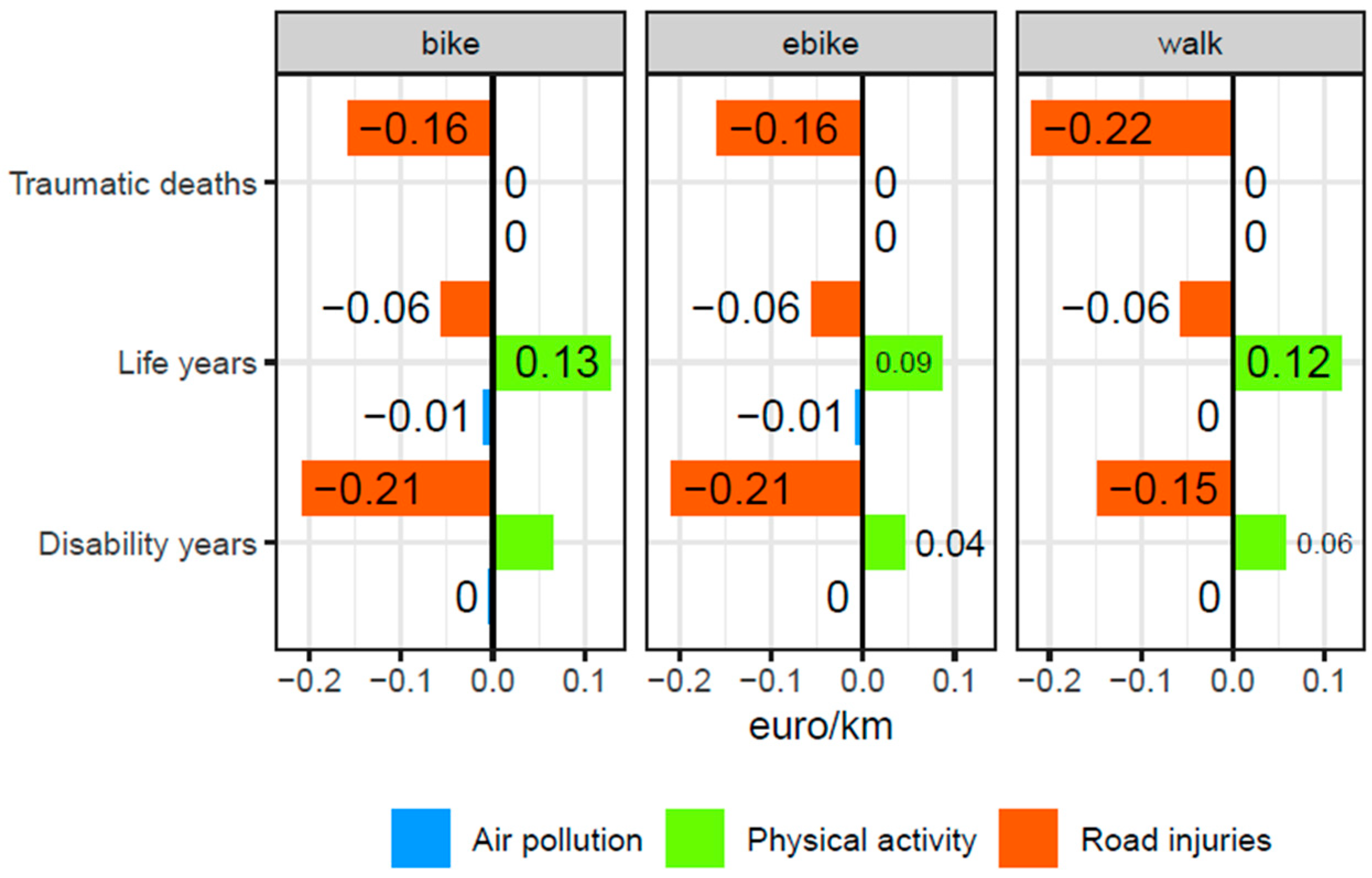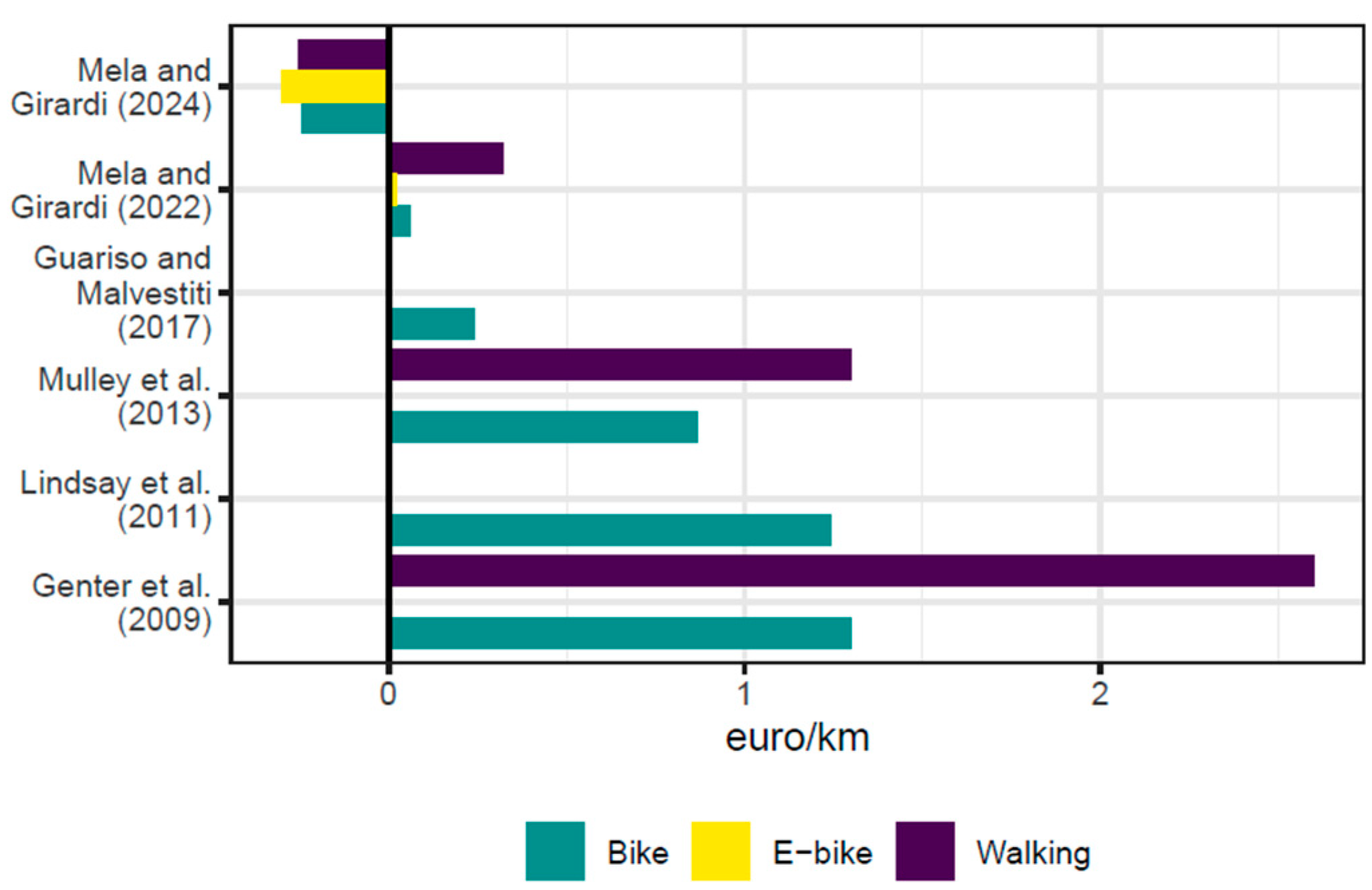Correction: Mela, G.; Girardi, P. Is Active Mobility Really a Sustainable Way of Travelling in Italian Cities? When and Where Injury Risk Offsets the Benefits of Riding or Walking. Sustainability 2024, 16, 7432
- (1)
- Replacing Figures and Related Descriptions:
- (a)
- (b)
- The figures in the published version (Figures 3, 4 and 7–10) displayed incorrect results. These figures have now been replaced with the correct ones, which reflect the accurate data analysis.
- (2)
- Replacing Textual Content in the Results and Discussion Sections:
- The overall health effect of the modal shift is negative, but it is lower in absolute value than originally reported.
- We rephrased the results in Section 3 to reflect the revised figures for road injury risks, the health impact values in EUR/km, and the city-specific conclusions (e.g., with Naples now being the only city where walking shows a positive impact).
- (3)
- Correct a Sentence in the Conclusions section, Paragraph 3, the correct content is as following:
- (4)
- Clarification in City-Specific Results (Section: Results; Paragraphs 8 and 11):
- From cars to walking: Naples;
- From cars to conventional bikes: Palermo and Florence;
- From cars to e-bikes: Palermo.
- (5)
- Addition to the Acknowledgments Section:
Reference
- Mela, G.; Girardi, P. Is Active Mobility Really a Sustainable Way of Travelling in Italian Cities? When and Where Injury Risk Offsets the Benefits of Riding or Walking. Sustainability 2024, 16, 7432. [Google Scholar] [CrossRef]






Disclaimer/Publisher’s Note: The statements, opinions and data contained in all publications are solely those of the individual author(s) and contributor(s) and not of MDPI and/or the editor(s). MDPI and/or the editor(s) disclaim responsibility for any injury to people or property resulting from any ideas, methods, instructions or products referred to in the content. |
© 2025 by the authors. Licensee MDPI, Basel, Switzerland. This article is an open access article distributed under the terms and conditions of the Creative Commons Attribution (CC BY) license (https://creativecommons.org/licenses/by/4.0/).
Share and Cite
Mela, G.; Girardi, P. Correction: Mela, G.; Girardi, P. Is Active Mobility Really a Sustainable Way of Travelling in Italian Cities? When and Where Injury Risk Offsets the Benefits of Riding or Walking. Sustainability 2024, 16, 7432. Sustainability 2025, 17, 8184. https://doi.org/10.3390/su17188184
Mela G, Girardi P. Correction: Mela, G.; Girardi, P. Is Active Mobility Really a Sustainable Way of Travelling in Italian Cities? When and Where Injury Risk Offsets the Benefits of Riding or Walking. Sustainability 2024, 16, 7432. Sustainability. 2025; 17(18):8184. https://doi.org/10.3390/su17188184
Chicago/Turabian StyleMela, Giulio, and Pierpaolo Girardi. 2025. "Correction: Mela, G.; Girardi, P. Is Active Mobility Really a Sustainable Way of Travelling in Italian Cities? When and Where Injury Risk Offsets the Benefits of Riding or Walking. Sustainability 2024, 16, 7432" Sustainability 17, no. 18: 8184. https://doi.org/10.3390/su17188184
APA StyleMela, G., & Girardi, P. (2025). Correction: Mela, G.; Girardi, P. Is Active Mobility Really a Sustainable Way of Travelling in Italian Cities? When and Where Injury Risk Offsets the Benefits of Riding or Walking. Sustainability 2024, 16, 7432. Sustainability, 17(18), 8184. https://doi.org/10.3390/su17188184




